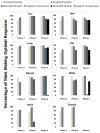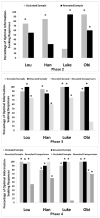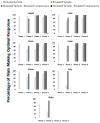Information seeking by rhesus monkeys (Macaca mulatta) and capuchin monkeys (Cebus apella)
- PMID: 21459372
- PMCID: PMC3095768
- DOI: 10.1016/j.cognition.2011.02.016
Information seeking by rhesus monkeys (Macaca mulatta) and capuchin monkeys (Cebus apella)
Erratum in
- Cognition. 2012 Feb;122(2):264-5
Abstract
Animal metacognition is an active, growing research area, and one part of metacognition is flexible information-seeking behavior. In Roberts et al. (2009), pigeons failed an intuitive information-seeking task. They basically refused, despite multiple fostering experiments, to view a sample image before attempting to find its match. Roberts et al. concluded that pigeons' lack of an information-seeking capacity reflected their broader lack of metacognition. We report a striking species contrast to pigeons. Eight rhesus macaques and seven capuchin monkeys passed the Roberts et al. test of information seeking-often in their first testing session. Members of both primate species appreciated immediately the lack of information signaled by an occluded sample, and the need for an information-seeking response to manage the situation. In subsequent testing, macaques demonstrated flexible/varied forms of information management. Capuchins did not. The research findings bear on the phylogenetic distribution of metacognition across the vertebrates, and on the underlying psychological requirements for metacognitive and information-seeking performances.
Copyright © 2011 Elsevier B.V. All rights reserved.
Figures






Similar articles
-
What are my chances? Closing the gap in uncertainty monitoring between rhesus monkeys (Macaca mulatta) and capuchin monkeys (Cebus apella).J Exp Psychol Anim Learn Cogn. 2014 Jul;40(3):303-16. doi: 10.1037/xan0000020. J Exp Psychol Anim Learn Cogn. 2014. PMID: 25368870 Free PMC article.
-
Hand preference for a bimanual task in tufted capuchins (Cebus apella) and rhesus macaques (Macaca mulatta).J Comp Psychol. 1996 Dec;110(4):406-11. doi: 10.1037/0735-7036.110.4.406. J Comp Psychol. 1996. PMID: 8956511
-
Information seeking in capuchins (Cebus apella): a rudimentary form of metacognition?Anim Cogn. 2015 May;18(3):667-81. doi: 10.1007/s10071-015-0835-7. Epub 2015 Jan 15. Anim Cogn. 2015. PMID: 25588604
-
Conceptual thresholds for same and different in old-(Macaca mulatta) and new-world (Cebus apella) monkeys.Behav Processes. 2011 Mar;86(3):316-22. doi: 10.1016/j.beproc.2011.01.001. Epub 2011 Jan 14. Behav Processes. 2011. PMID: 21238555 Free PMC article.
-
Capuchin monkey research priorities and urgent issues.Am J Primatol. 2014 Aug;76(8):705-20. doi: 10.1002/ajp.22269. Epub 2014 Mar 25. Am J Primatol. 2014. PMID: 24668460 Review.
Cited by
-
Explicit memory and cognition in monkeys.Neuropsychologia. 2020 Feb 17;138:107326. doi: 10.1016/j.neuropsychologia.2019.107326. Epub 2020 Jan 7. Neuropsychologia. 2020. PMID: 31917205 Free PMC article. Review.
-
Information seeking about tool properties in great apes.Sci Rep. 2017 Sep 7;7(1):10923. doi: 10.1038/s41598-017-11400-z. Sci Rep. 2017. PMID: 28883523 Free PMC article.
-
Executive-attentional uncertainty responses by rhesus macaques (Macaca mulatta).J Exp Psychol Gen. 2013 May;142(2):458-75. doi: 10.1037/a0029601. Epub 2012 Aug 13. J Exp Psychol Gen. 2013. PMID: 22889164 Free PMC article.
-
A Dissociative Framework for Understanding Same-Different Conceptualization.Curr Opin Behav Sci. 2021 Feb;37:13-18. doi: 10.1016/j.cobeha.2020.06.004. Epub 2020 Jul 15. Curr Opin Behav Sci. 2021. PMID: 34124319 Free PMC article.
-
Retrospective and prospective metacognitive judgments in rhesus macaques (Macaca mulatta).Anim Cogn. 2014 Mar;17(2):249-57. doi: 10.1007/s10071-013-0657-4. Epub 2013 Jun 30. Anim Cogn. 2014. PMID: 23812677 Free PMC article.
References
Publication types
MeSH terms
Grants and funding
LinkOut - more resources
Full Text Sources

